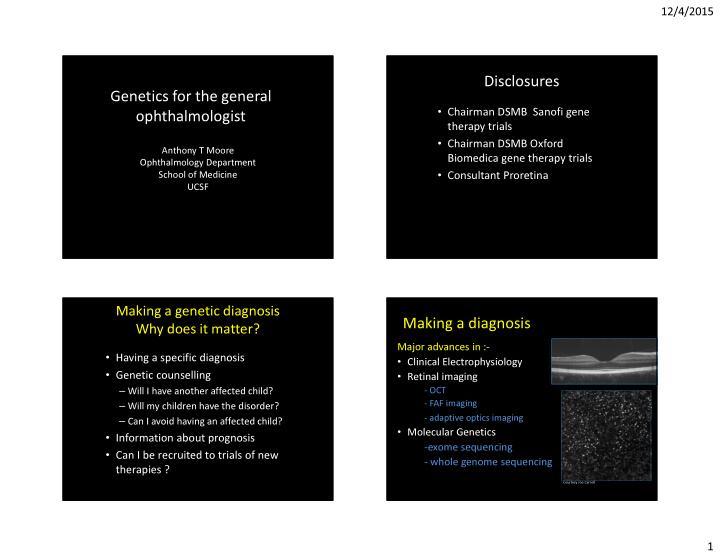



12/4/2015 Disclosures Genetics for the general • Chairman DSMB Sanofi gene ophthalmologist therapy trials • Chairman DSMB Oxford Anthony T Moore Biomedica gene therapy trials Ophthalmology Department • Consultant Proretina School of Medicine UCSF Making a genetic diagnosis Making a diagnosis Why does it matter? Major advances in :- • Having a specific diagnosis • Clinical Electrophysiology • Genetic counselling • Retinal imaging – Will I have another affected child? - OCT - FAF imaging – Will my children have the disorder? - adaptive optics imaging – Can I avoid having an affected child? • Molecular Genetics • Information about prognosis -exome sequencing • Can I be recruited to trials of new - whole genome sequencing therapies ? Courtesy Joe Carroll 1
12/4/2015 Does this child have eye findings of Role of general ophthalmologist this syndromic disorder? • To recognise the possibility of diagnosis of inherited eye disease • Give advice if feel confident to do so or make an appropriate referral • To be able to recognise eye abnormalities in patients with diagnosis of a syndromic disorders • It helps to work closely with your local clinical geneticist Key points Case 1: Congenital cataract • Take a good history • Age 4 months – Ocular and systemic • Dense bilateral • Family History cataracts • Parental consanguinity? • Any other medical problems? • No family history of • Does the child look normal? cataract – Any dysmorphism • Parents ask ' What is the – Any other obvious impairments risk of having another affected child?' • Examine other family members 2
12/4/2015 Mother age 30 years Vision 20/20 Case 2 Presented with dense cataracts at birth No FH Usual investigations for cataract negative at birth • Torch Screen • reducing sugars • Calcium and electrolytes • urinary aas Diagnosis AD CC 1 in 2 risk of having another affected child Mothers examination Lowe syndrome (OCRL) Does the child look normal ? VA 20/20 OU • X-linked disorder • Mental retardation Case 3 • Cataract • Renal Fanconi syndrome Age 2 months Female carriers have typical Cataracts notes at 6 week lens changes check by family doctor Parental concerns about Urinary amino acids repeated – positive appearence Molecular genetic testing Previous pediatric diagnosis confirms diagnosis of Pierre-Robin sequence Major implications for management and genetic counseling 3
12/4/2015 Hallerman- Streiff syndrome Common misdiagnoses: Infantile onset nystagmus Differential diagnosis • Leber amaurosis Sporadic disorder Low recurrence risk • Congenital stationary night blindness Characteristic facies Micrognathia • Cone dysfunction syndromes Airway problems - achromatopsia Microphthalmos -S cone monochromatism Cataract • Albinism Spontaneous resorption common • CIMN Case 4 Key points in infantile nystagmus 9 year old girl • Any FH of nystagmus? Diagnosed in infancy with congenital nystagmus • Photophobia or night blindness? 'Not genetic' 4 years later newborn sibling • Nystagmus typical of CIMN had nystagmus or atypical • Examine child on slit lamp Va 20/200 OU -iris translucency -iris hypoplasia No color vision Absent cone ERG • Refraction Normal rod ERG • Key role of electrophysiology 4
12/4/2015 Examine the mothers of all male infants with Refraction nystagmus on slit lamp High refractive errors in:- Albinism Aniridia Retinal dystrophies Diagnosis : Female carrier X-linked ocular albinism ERG and VEP in awake children Albino chiasmal misrouting Photopic 30Hz DA Rt eye Lt eye ERG: Peri-orbital electrodes b- Normal b- Normal Albino a- a- (Courtesy of G.Holder) 5
12/4/2015 F, 7 yrs. EDD 35661. Oculo-cutaneous albinism. VAR, VAL 6/24 Modern imaging techniques are very helpful in diagnosis R eye Pattern • In a child with unexplained poor appearance vision perform OCT especially if L eye electrophysiology is not easily available • Fundus autofluorescence imaging R eye helpful in specific diagnosis Flash L eye 8 year old boy . Failed school eye test . Age 7 years VA 20/50 OU 'Normal fundus' Failed school eye test Vision 20/60 ou Normal fundus 'Probable functional visual loss ' OCT confirms a retinal cause Diagnosis KCNV2 retinopathy Diagnosis X-linked retinoschisis 6
12/4/2015 Fundus autofluorescence imaging Another tip Always keep diagnosis under review As new information becomes available may need to change diagnosis Family 1 Family 1 10 years later • Niece of index case , age 9 yrs ,referred by optician because of abnormal fundus • Asymptomatic, normal acuity Age 25 From Pakistan Severe RP Brother also affected Registered blind Myopia Diagnosis ARRP 7
12/4/2015 What patients will ask ? Age 14 years female Night blindness 5 years What is diagnosis ? No FH What is the treatment? VA 6/9 OU What about new treatments? No detectable rod responses and abnormal cone responses on ERG Stem cells Gene therapy ‘Bionic eye ‘ Tapetal reflex Diagnosis X-linked RP Eye transplants Think about X-linked inheritance in male Placental extracts sibships Cranial osteopathy Homeopathy Examine mothers or daughters of males Cannabis with severe RP Patient and clinical resources For the clinician OMIM Orphanet Gene Clinics Pubmed Mr. Google – find out what your patients are reading For the patient Foundation Fighting Blindness Other support groups Social media 8
Recommend
More recommend